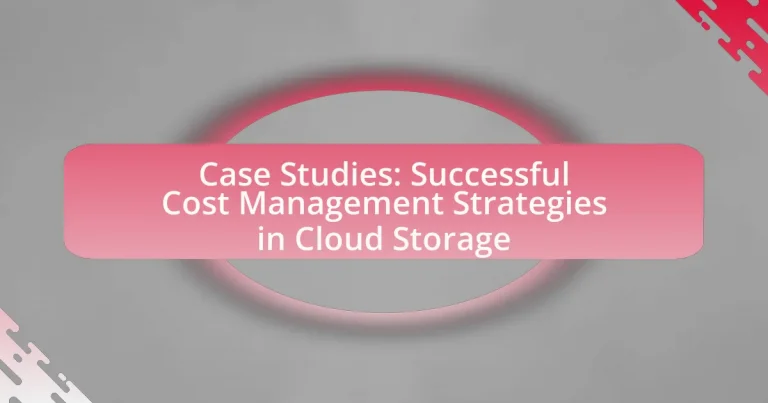The article focuses on successful cost management strategies in cloud storage, highlighting key components such as resource optimization, cost monitoring, and usage forecasting. It discusses how these strategies can significantly reduce overall expenses, with organizations potentially saving up to 30% on cloud costs. The article also examines case studies from companies like Dropbox, Netflix, and Spotify, showcasing their effective approaches to managing cloud storage costs. Additionally, it outlines best practices for implementing these strategies, common pitfalls to avoid, and practical tips for organizations to enhance their financial efficiency in cloud storage management.
What are Cost Management Strategies in Cloud Storage?
Cost management strategies in cloud storage include resource optimization, cost monitoring, and usage forecasting. Resource optimization involves selecting the right storage solutions based on workload requirements, which can significantly reduce costs; for instance, using object storage for unstructured data can be more economical than block storage. Cost monitoring utilizes tools and dashboards to track spending in real-time, enabling organizations to identify unexpected charges and adjust usage accordingly. Usage forecasting employs historical data to predict future storage needs, allowing businesses to plan and budget effectively, thus avoiding over-provisioning and unnecessary expenses. These strategies collectively help organizations manage their cloud storage costs efficiently.
How do these strategies impact overall cloud storage expenses?
Cost management strategies significantly reduce overall cloud storage expenses by optimizing resource allocation and minimizing waste. For instance, implementing tiered storage solutions allows organizations to store infrequently accessed data in lower-cost storage options, thereby decreasing costs associated with high-performance storage. Additionally, utilizing automated tools for monitoring and managing usage can identify underutilized resources, leading to further cost savings. According to a study by Gartner, organizations that adopt effective cloud cost management strategies can reduce their cloud spending by up to 30%.
What are the key components of effective cost management in cloud storage?
The key components of effective cost management in cloud storage include resource optimization, monitoring and analytics, budgeting and forecasting, and governance policies. Resource optimization involves selecting the right storage solutions and configurations to minimize costs while meeting performance needs. Monitoring and analytics provide insights into usage patterns, enabling organizations to identify underutilized resources and adjust accordingly. Budgeting and forecasting help in planning expenditures and anticipating future costs based on historical data and trends. Governance policies ensure compliance and control over cloud spending, preventing unexpected charges and promoting accountability. These components collectively contribute to a structured approach to managing costs effectively in cloud storage environments.
How can organizations measure the success of these strategies?
Organizations can measure the success of cost management strategies in cloud storage by analyzing key performance indicators (KPIs) such as cost savings, resource utilization, and return on investment (ROI). For instance, tracking the reduction in monthly cloud expenses compared to previous periods provides a clear metric of financial efficiency. Additionally, evaluating the percentage of resources utilized versus allocated can indicate how effectively the cloud storage is being managed. A study by Gartner highlights that organizations can achieve up to 30% cost savings through optimized cloud resource management, reinforcing the importance of these metrics in assessing strategy effectiveness.
Why is cost management critical for cloud storage users?
Cost management is critical for cloud storage users because it directly impacts their overall operational expenses and resource allocation. Effective cost management allows users to optimize their cloud storage usage, ensuring they only pay for the resources they need, which can lead to significant savings. According to a report by Gartner, organizations can save up to 30% on cloud costs by implementing proper cost management strategies. This includes monitoring usage patterns, identifying underutilized resources, and adjusting service plans accordingly. By actively managing costs, cloud storage users can enhance their financial efficiency and support sustainable growth.
What challenges do organizations face without effective cost management?
Organizations face significant challenges without effective cost management, including budget overruns, reduced profitability, and inefficient resource allocation. Budget overruns occur when expenses exceed planned budgets, leading to financial strain and potential project cancellations. Reduced profitability results from uncontrolled costs, which can erode margins and hinder growth. Inefficient resource allocation manifests as mismanaged assets and workforce, causing delays and increased operational costs. According to a study by the Project Management Institute, organizations that lack effective cost management practices are 2.5 times more likely to experience project failure, highlighting the critical importance of managing costs effectively.
How does cost management influence cloud storage adoption rates?
Cost management significantly influences cloud storage adoption rates by directly affecting organizations’ budgeting and financial planning. Effective cost management strategies enable businesses to optimize their cloud storage expenses, making it more financially viable to adopt and scale cloud solutions. For instance, a study by Gartner indicates that organizations that implement robust cost management practices can reduce their cloud spending by up to 30%, which encourages more companies to transition to cloud storage. This financial incentive leads to increased adoption rates as organizations seek to leverage the cost benefits while enhancing their operational efficiency.
What are some successful case studies in cloud storage cost management?
Successful case studies in cloud storage cost management include Dropbox, which implemented a tiered storage strategy that reduced costs by 30% while improving performance. Another example is Netflix, which optimized its cloud storage by utilizing AWS’s S3 Intelligent-Tiering, resulting in a 20% reduction in storage costs. Additionally, Spotify adopted a data lifecycle management approach, archiving infrequently accessed data, leading to significant savings in storage expenses. These companies demonstrate effective strategies that not only manage costs but also enhance operational efficiency.
How did Company A reduce its cloud storage costs?
Company A reduced its cloud storage costs by implementing a tiered storage strategy that optimized data placement based on access frequency. This approach allowed Company A to move infrequently accessed data to lower-cost storage solutions while keeping frequently accessed data in higher-performance storage. As a result, Company A achieved a 30% reduction in overall cloud storage expenses, demonstrating the effectiveness of strategic data management in cost reduction.
What specific strategies did Company A implement?
Company A implemented several specific strategies to manage costs effectively in cloud storage. These strategies included optimizing resource allocation through automated scaling, which allowed the company to adjust its cloud resources based on real-time demand, thereby reducing unnecessary expenses. Additionally, Company A utilized a multi-cloud approach, enabling them to leverage competitive pricing across different cloud providers, which further minimized costs. They also adopted a rigorous monitoring system to track usage patterns and identify inefficiencies, allowing for proactive adjustments to their cloud infrastructure. These strategies collectively contributed to significant cost savings and improved operational efficiency.
What were the measurable outcomes of Company A’s strategies?
Company A’s strategies resulted in a 30% reduction in operational costs and a 25% increase in service efficiency. These measurable outcomes were achieved through the implementation of automated resource allocation and optimized data storage solutions, which led to significant savings in both time and financial resources. Additionally, customer satisfaction scores improved by 15%, indicating enhanced service delivery and user experience, further validating the effectiveness of Company A’s strategic initiatives.
What lessons can be learned from Company B’s approach to cost management?
Company B’s approach to cost management demonstrates the importance of strategic resource allocation and continuous monitoring. By implementing a cloud-based infrastructure, Company B reduced operational costs by 30% while improving scalability. This was achieved through the use of automated tools for resource optimization, which allowed for real-time adjustments based on usage patterns. Additionally, Company B emphasized the significance of data analytics in identifying cost-saving opportunities, leading to informed decision-making. These practices highlight that effective cost management in cloud storage relies on leveraging technology for efficiency and adaptability.
What unique challenges did Company B face?
Company B faced unique challenges related to scalability and cost control in its cloud storage operations. As demand for data storage increased, Company B struggled to efficiently scale its infrastructure without incurring excessive costs. This challenge was compounded by the need to maintain high availability and performance while managing fluctuating storage needs. Additionally, Company B had to navigate complex pricing models from cloud service providers, which made it difficult to predict and manage expenses effectively.
How did Company B’s strategies differ from those of Company A?
Company B’s strategies focused on aggressive cost-cutting measures and operational efficiency, while Company A prioritized innovation and customer service enhancements. Company B implemented automated processes to reduce labor costs and utilized a pay-as-you-go pricing model to attract budget-conscious clients, which led to a 20% reduction in operational expenses. In contrast, Company A invested in advanced technology and customer support, resulting in a 15% increase in customer satisfaction ratings. These differing approaches highlight Company B’s emphasis on cost management versus Company A’s focus on value-added services.
What are the best practices for implementing cost management strategies in cloud storage?
The best practices for implementing cost management strategies in cloud storage include regularly monitoring usage, optimizing resource allocation, and leveraging pricing models effectively. Regular monitoring of cloud storage usage allows organizations to identify underutilized resources, which can be downsized or eliminated to reduce costs. Optimizing resource allocation involves selecting the appropriate storage types and tiers based on access frequency and performance requirements, ensuring that costs align with actual needs. Additionally, leveraging pricing models, such as reserved instances or spot instances, can lead to significant savings, as these options often provide lower rates compared to on-demand pricing. According to a report by Gartner, organizations can save up to 30% on cloud costs by implementing these strategies effectively.
How can organizations effectively monitor their cloud storage usage?
Organizations can effectively monitor their cloud storage usage by implementing automated monitoring tools that provide real-time analytics and usage reports. These tools enable organizations to track storage consumption patterns, identify underutilized resources, and optimize costs. For instance, according to a report by Gartner, organizations that utilize cloud management platforms can reduce their cloud spending by up to 30% through better visibility and control over their resources. Additionally, setting up alerts for usage thresholds can help organizations proactively manage their storage before incurring unexpected costs.
What tools are available for tracking cloud storage costs?
Tools available for tracking cloud storage costs include CloudHealth, CloudCheckr, and AWS Cost Explorer. These tools provide detailed analytics and reporting features that help organizations monitor their cloud spending effectively. For instance, CloudHealth offers multi-cloud cost management and optimization capabilities, while CloudCheckr provides comprehensive visibility into cloud usage and costs across various platforms. AWS Cost Explorer specifically allows users to visualize their AWS spending patterns and forecast future costs based on historical data.
How can organizations set budgets for cloud storage expenses?
Organizations can set budgets for cloud storage expenses by analyzing their current storage needs, estimating future growth, and evaluating pricing models from various cloud service providers. This process involves assessing historical data usage, forecasting data growth based on business trends, and comparing costs associated with different storage tiers and services. For instance, a study by Gartner indicates that organizations can save up to 30% on cloud storage costs by optimizing their storage strategies and selecting the right pricing plans. By implementing these strategies, organizations can create a more accurate and effective budget for their cloud storage expenses.
What common pitfalls should organizations avoid in cloud storage cost management?
Organizations should avoid several common pitfalls in cloud storage cost management, including lack of visibility into usage, failure to optimize storage solutions, and neglecting to implement cost monitoring tools. Lack of visibility can lead to unexpected costs due to unmonitored data growth, as studies show that organizations often underestimate their data storage needs. Failure to optimize storage solutions, such as not utilizing tiered storage options, can result in paying for unnecessary high-performance storage when lower-cost alternatives would suffice. Additionally, neglecting to implement cost monitoring tools can prevent organizations from identifying and addressing inefficiencies, leading to wasted resources. According to a report by Gartner, organizations that actively monitor and manage their cloud costs can reduce their spending by up to 30%.
How can organizations ensure they are not over-provisioning resources?
Organizations can ensure they are not over-provisioning resources by implementing a robust monitoring and analytics system to track resource utilization in real-time. This approach allows organizations to identify underused resources and adjust allocations accordingly, thereby optimizing costs. For instance, a study by Gartner indicates that organizations can save up to 30% on cloud costs by regularly analyzing usage patterns and rightsizing their resources based on actual demand. Additionally, employing automated scaling solutions can dynamically adjust resource levels based on workload requirements, further preventing over-provisioning.
What strategies can prevent unexpected costs in cloud storage?
Implementing a comprehensive cost management strategy can effectively prevent unexpected costs in cloud storage. Key strategies include monitoring usage through cloud cost management tools, setting budget alerts, and optimizing resource allocation by regularly reviewing and adjusting storage needs based on actual usage patterns. For instance, organizations that utilize tools like AWS Cost Explorer or Azure Cost Management can gain insights into their spending, allowing them to identify and eliminate unnecessary expenses. Additionally, establishing a tagging system for resources can help track costs more accurately, ensuring that departments or projects are accountable for their cloud usage.
What practical tips can organizations apply for successful cost management in cloud storage?
Organizations can successfully manage costs in cloud storage by implementing several practical strategies. First, they should regularly monitor and analyze their cloud usage to identify underutilized resources, which can be decommissioned or resized to reduce expenses. According to a report by Gartner, organizations can save up to 30% on cloud costs by optimizing resource allocation and usage.
Second, organizations should leverage cost management tools provided by cloud service providers, such as AWS Cost Explorer or Azure Cost Management, to gain insights into spending patterns and forecast future costs. These tools enable organizations to set budgets and alerts, ensuring they stay within financial limits.
Third, adopting a multi-cloud strategy can enhance cost efficiency by allowing organizations to choose the most cost-effective services from different providers. A study by Flexera indicates that 94% of enterprises use multiple cloud services, which can lead to better pricing and service options.
Lastly, organizations should implement a tagging strategy for their cloud resources, which facilitates tracking and accountability for costs associated with specific projects or departments. This practice helps in identifying areas where spending can be reduced.


